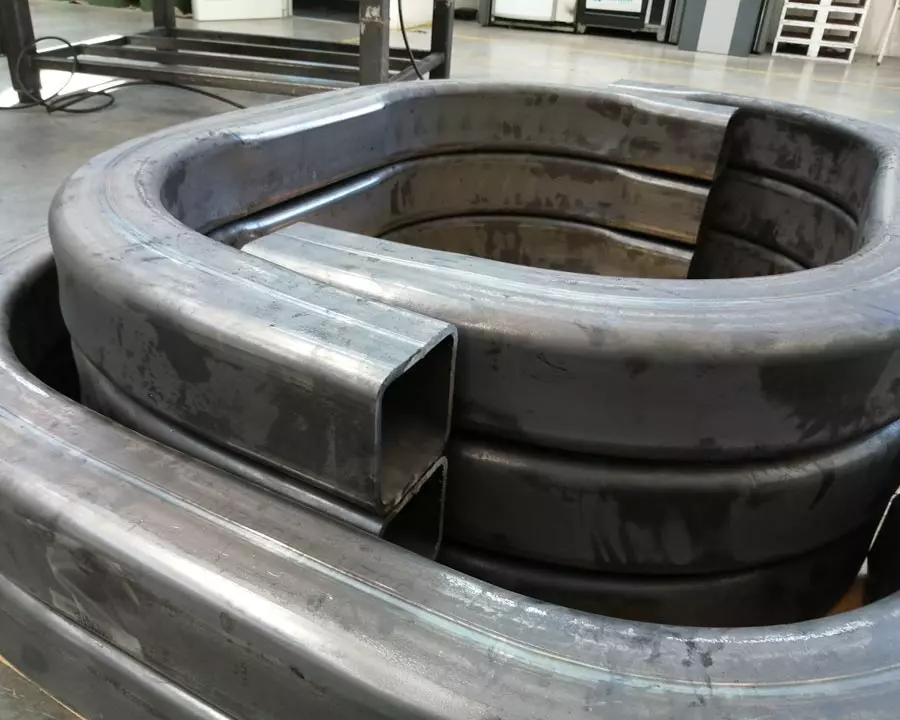Bending steel tubes and pipes
Steel is the soul of our company.
Nothing less than a precious metal for us, steel is the metal we use most here at Tecnocurve.
Its characteristics of excellent deformability and hardness, its resistance to wear and its hardenability, as well as the countless ways it can be recycled, all make it ideal for the production of structural parts that can then be used in different sectors such as agriculture, carpentry, the production of cabs and much more.
Processing iron tubes and section bars
One of the most widely appreciated characteristics in the bending of iron tubes is certainly its reduced cost, especially if compared to the same processing done on tubes in stainless steel.
Inspections
When the tubes and section bars are delivered to the company, our special division performs strict tests of the measurements and quality control. This first passage is fundamental to ensure there will be no problems during the bending and roll bending stages.
Quality Certification
Delivery of the steel conformity certificate directly by the producer enables the client to maintain traceability of the bent iron tube supplied.
Types of tubes and relative cross sections
Over the years, thanks to our cumulative experience, we have equipped ourselves with increasingly evolved bending machines, which have enabled us in time, and even more now, to work on standard cross sections but also on special cross sections for the bending of iron section bars.
Thanks to the experience acquired in the activity of tube bending and facilitated by the fleet of latest generation machines with which we have equipped our company, we can satisfy all the geometrical designs requested, from the simplest to the most complex.
Round steel pipes
- Minimum cross section: Ø6 mm
- Maximum cross section: Ø219 mm
Square steel tubes
- Minimum cross section: 10x10 mm
- Maximum cross section: 180x180 mm
Rectangular tubular elements
- Minimum cross section: 20x10 mm
- Maximum cross section: 150x100 mm
Steel section bars
- To determine whether a special section bar in steel can be processed by cold bending, a thorough feasibility study by our technical office will always be necessary.

Methods of bending and processing pipes and tubes
Just because it is one of the easiest metals to process by cold bending, steel is also one of the most widely used.
Metal tubes and pipes in steel are used in both bending and roll bending processes. Moreover, bent steel tubes can then be cut with the laser tube even to high thicknesses, with a diameter of the tube as great as 230 mm.
Bending
Steel pipes and tubes are bent using a CNC full electric tube bending machine that can guarantee precision and repeatability.
For this specific type of tube processing, Tecnocurve disposes of various pieces of equipment that can function with a high range of cross sections.
The steel tube is bent based on a fixed radius which, for this reason, is called the bend radius.
Roll Bending
Roll bent steel pipes are characterized by a wide bend radius.
The most important difference between bending and roll bending is, in fact, the bend radius of the tube, narrow in the former case, wider in the latter.
The other difference is that it is only with roll bending that the same metal tube can be bent with different bend radii.
Roll bending is, basically, an easier task that bending, and is done on CNC roll bending machines with three rollers.
Laser cutting
Thanks to the use of laser cutting on tubular elements that will then be bent or roll bent, it is possible to process cross sections with thicknesses up to 15 mm.
Thanks to the laser, we can do more than cutting: we can also drill holes and cut slots of various shapes and sizes, make mitre cuts at the ends and apply markings.
The laser cutter (laser tube) for tubes and section bars in steel gives us a high quality result in less time with lower costs that we could achieve with other methods.
Other metals we process
Aluminum
Esthetics and resistance to corrosion are the primary considerations of those who choose this metal.
It has many applications in the construction sector just because of its high resistance to corrosion due to atmospheric agents, as well as for its mechanical characteristics that reduce the thicknesses necessary with other types of metals.
Stainless steel
Estetica e resistenza alla corrosione sono aspetti di primaria importanza se si sceglie di curvare questo metallo.
Trova molteplici applicazioni nel settore edile proprio grazie alla elevata resistenza alla deterioramento dovuto ad agenti atmosferici e alle caratteristiche meccaniche che riducono gli spessori necessari rispetto ad altri tipi di metalli.
